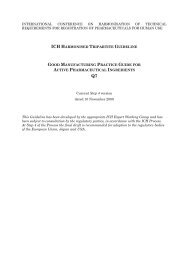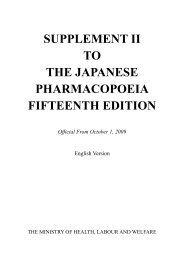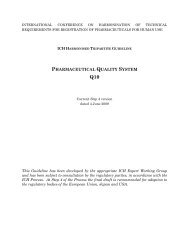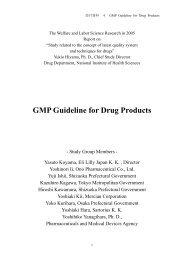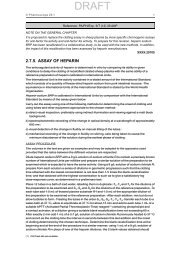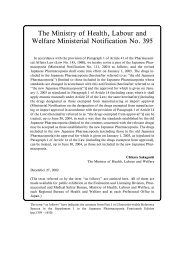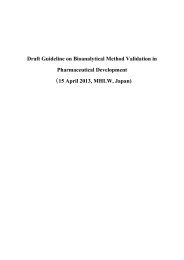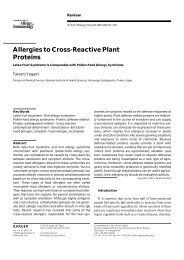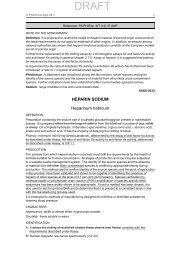PFSB/ELD/OMDE (Yakushokuki) Notification 1207 No.1 December ...
PFSB/ELD/OMDE (Yakushokuki) Notification 1207 No.1 December ...
PFSB/ELD/OMDE (Yakushokuki) Notification 1207 No.1 December ...
You also want an ePaper? Increase the reach of your titles
YUMPU automatically turns print PDFs into web optimized ePapers that Google loves.
<strong>PFSB</strong>/<strong>ELD</strong>/<strong>OMDE</strong> (<strong>Yakushokuki</strong>) <strong>Notification</strong> <strong>1207</strong> <strong>No.1</strong><br />
<strong>December</strong> 7, 2011<br />
Attn: Directors of Prefectural Public Health Departments/Bureaux<br />
Director, Office of Medical Devices Evaluation<br />
Evaluation and Licensing Division, Pharmaceutical and Food Safety Bureau<br />
Ministry of Health, Labour and Welfare<br />
Re: Publication of the Guidance for the Evaluation of Emerging Technology Medical Devices<br />
The Ministry of Health, Labour and Welfare of Japan intends to establish a guidance for the<br />
evaluation of emerging technology medical devices, for which there is a high demand in<br />
clinical practice, by selecting the target areas to be studied in order to facilitate efficient<br />
product development and speed up the approval process through the advance preparation and<br />
publication of documents, such as a guidance for technical evaluation, to be used for the<br />
review.<br />
Here, we present the guidance comprising the documents that may be required for the<br />
evaluation of cell sheets used in the regeneration of periodontal tissue, orthopedic customized<br />
artificial hip joint prostheses and computer-aided diagnostic devices, and the advice for<br />
evaluation. We would like your cooperation in promulgating this guidance among the relevant<br />
vendors and service providers under your jurisdiction for use as a reference when filing an<br />
application for manufacturing/marketing approval. Attention should be paid to the following<br />
points.<br />
(For your reference, copies of this notification will also be sent to the Chief Executive of the<br />
Pharmaceutical and Medical Devices Agency, Chairman of the Japan Federation of Medical<br />
Devices Associations, Chairman of the American Medical Devices and Diagnostics<br />
Manufacturers’ Association, and the Chairman of the Medical Equipment Committee of the<br />
Council of the European Business Community in Japan.)<br />
1. The guidance makes recommendations regarding points that should be considered in<br />
product evaluation (evaluation items) from the viewpoints of collecting application<br />
documents for approval and accelerating the review process. The guidance is not
positioned as a legal standard but is designed simply to suggest currently recognized<br />
evaluation items for emerging technology medical devices. It has to be noted that other<br />
kinds of evaluation may be needed, or there may be some exceptions to this guidance<br />
depending on the product characteristics.<br />
2. When collecting documents and data required for submission of an application for<br />
approval of individual products, it is recommended that the issues presented in the<br />
guidance be discussed in advance, and to use the consultation service of the<br />
Pharmaceutical and Medical Devices Agency at the earliest possible opportunity.
(Attachment 2)<br />
Guidance on Evaluation of Orthopedic Customized Artificial Hip Joint Prosthesis<br />
1. Introduction<br />
In the field of orthopedics, implants (classified as “medical devices” by the Pharmaceutical<br />
Affairs Law) have been used widely as ready-made implants due to their proven mechanical<br />
and biological safety and efficacy, and have contributed to the improvement in the quality of<br />
medical care and the lives of people in Japan. However, in clinical practice, bone structure<br />
and geometry vary among individual patients, and there are reports of cases where readymade<br />
implants cannot be used effectively. Therefore, there is a compelling need for implants<br />
with greater compatibility for individual patients, so-called customized implants, as a solution<br />
to the problem of biological incompatibility.<br />
Because customized implants are compatible with individual patients, they are expected to<br />
play a major role in the introduction of bone preservation therapies, ensuring compatibility<br />
and stability, implementation of less invasive surgical procedures, successful functional<br />
reconstruction, improvement of implant service life, early rehabilitation and reentry into<br />
society, and reduction in the need for revision surgery. In other words, it will be beneficial not<br />
only for patients and medical workers but also in terms of medical economics to have the<br />
needs of patients and medical workers satisfied and to secure excellent clinical results through<br />
the clinical adoption of customized implants that meet the requirements of individual patients.<br />
As technological innovation has made marked advances and made it possible to produce<br />
customized implants that meet such clinical needs, it is now feasible to produce safer implants<br />
with better biocompatibility.<br />
Customized implants are expected to be used for applications such as joint prostheses and<br />
devices for osteosynthesis. In clinical practice, joint prostheses (e.g., artificial hip joint, knee<br />
joint, shoulder joint, and elbow joint) are typical examples of applications that require<br />
customized implants optimally shaped to fit various bone geometries and accommodate<br />
serious bone defects and/or deformations. This guidance is designed to specify the<br />
requirements for customized artificial hip joint prostheses for which there is a high demand in<br />
clinical practice.
2. Scope<br />
Among orthopedic implants, the scope of this guidance is artificial hip joint prostheses<br />
(including femoral head prosthesis). In this guidance, a customized artificial hip joint<br />
prosthesis is defined as an artificial hip joint prosthesis with improved biocompatibility and<br />
stability achieved through minimal modification to the shape of a ready-made prosthesis in<br />
order to match the bone geometry of an individual patient for whom a ready-made prosthesis<br />
is not suitable.<br />
3. Role of This Guidance<br />
In consideration of the fact that the scope is orthopedic artificial hip joint prostheses<br />
(including femoral head prosthesis) that are being developed based on the remarkable<br />
technological advances occurring in this area, this guidance is designed to indicate current<br />
issues instead of providing a comprehensive list of problems and points to consider.<br />
Therefore, it will be revised as technological innovation progresses and knowledge<br />
accumulates, and it does not mandate what information must be included in application<br />
documents for approval.<br />
For the evaluation of customized artificial hip joint prostheses, it is necessary to have a<br />
thorough understanding of the characteristics of individual products and to handle the data in<br />
a flexible and scientifically rational manner.<br />
It is also recommended that other relevant guidelines from both Japan and overseas should be<br />
consulted in addition to this guidance.<br />
4. Contents of Written Application for Approval of Customized Artificial Hip Joint<br />
Prosthesis<br />
(1) Form, Structure and Mechanism<br />
In the section “Form, Structure and Mechanism,” specify the dimensional ranges in which the<br />
customized artificial hip joint prosthesis can be produced, separately from the ready-made<br />
prosthesis upon which the production of customized prosthesis is based.
(2) Purpose of Use, Indications or Efficacy<br />
In the section “Purpose of Use, Indications or Efficacy,” specify that the customized artificial<br />
hip joint prosthesis is to be used in the following cases:<br />
1) When a physician judges that a sufficient therapeutic effect cannot be obtained with a<br />
ready-made prosthesis.<br />
2) When a physician judges that a more significant therapeutic effect can be obtained<br />
with a customized artificial hip joint prosthesis than with a ready-made prosthesis.<br />
(3) Product Specifications<br />
In terms of production and structure, specify the technological reference data showing that the<br />
performance of the customized artificial hip joint prosthesis is equivalent to or higher than<br />
that of the corresponding ready-made prosthesis.<br />
(4) Other<br />
1) Specify the data of the ready-made prosthesis used as the basis for producing the<br />
customized artificial hip joint prosthesis.<br />
2) Attach the draft specification form prepared by a physician.<br />
5. Evaluation of Customized Artificial Hip Joint Prosthesis<br />
(1) Evaluation of Production Technology<br />
Specify that the production technology is equivalent to that of the corresponding ready-made<br />
prosthesis, or equivalent or superior to that of other ready-made prostheses made or supplied<br />
by your own company and which have already been approved.<br />
(2) Evaluation of Safety<br />
Specify that the basic safety profile (e.g., biological safety) of the materials needed to produce<br />
the customized artificial hip joint prosthesis is equivalent or superior to that of the<br />
corresponding ready-made prosthesis. Submission of safety data on customized prostheses<br />
can be omitted if its safety can be proven using the data and scientific evidence for readymade<br />
prostheses. When it is determined that high functionality and durability are needed in<br />
clinical practice, submit the data and the scientific basis for similar biomaterials approved for<br />
use in artificial hip joint prostheses.
(3) Evaluation of Mechanical Safety<br />
Submission of mechanical safety data can be omitted if data are presented to show that the<br />
dimensions of the customized artificial hip joint prosthesis are within the range of the<br />
corresponding ready-made prosthesis, or that the mechanical safety is not inferior to that of<br />
the corresponding ready-made prosthesis.<br />
It is possible to show that the mechanical safety is not inferior to that of ready-made<br />
prosthesis by the following methods:<br />
1) When the customized artificial hip joint prosthesis is modified to make it mechanically<br />
safer than the corresponding ready-made prosthesis, mechanical safety testing can be<br />
omitted by specifying it using the Appendix listing items to be customized as a<br />
reference (test data on approved products made or supplied by your own company can<br />
also be used).<br />
2) When it is necessary to modify sites subjected to a structural load, specify that<br />
mechanical safety can be guaranteed based on a mechanical test performed in<br />
accordance with some other guideline (test data on approved products made or<br />
supplied by your own company can also be used).<br />
6. Preparation and Actions by Marketing Authorization Holder<br />
The marketing authorization holder shall prepare the documents stipulated in the Ordinance<br />
on Standards for Manufacturing Control and Quality Control of Medical Devices and in vitro<br />
Diagnostic Drugs (MHLW Ministerial Ordinance <strong>No.1</strong>69, 2004, “QMS Ordinance”),<br />
Ordinance on Standards for Quality Assurance for Drugs, Quasi-drugs, Cosmetics and<br />
Medical Devices (MHLW Ministerial Ordinance <strong>No.1</strong>36, 2004, “GQP Ordinance”),<br />
Ordinance on Standards for Post-marketing Safety Management for Drugs, Quasi-drugs,<br />
Cosmetics and Medical Devices (MHLW Ministerial Ordinance <strong>No.1</strong>35, 2004, “GVP<br />
Ordinance”), or the Ordinance on Standards for Post-marketing Survey and Examination of<br />
Medical Devices (MHLW Ministerial Ordinance No.38, 2005, “GPSP Ordinance”), and<br />
specify in the documents the following information in order to comply with these<br />
requirements.
(1) Design of Customized Artificial Hip Joint Prosthesis<br />
The marketing authorization holder shall design a customized artificial hip joint prosthesis<br />
within the range that has been approved in accordance with the written specifications prepared<br />
by a physician.<br />
(2) Documents to be Retained by Marketing Authorization Holder<br />
The marketing authorization holder shall keep the following documents related to the<br />
production of a customized artificial hip joint prosthesis and selling/offering it to the<br />
physician who prepared the written specifications.<br />
1) Name of the physician who prepared the written specifications<br />
2) Written specifications prepared by the physician (including data on the patient’s bone<br />
geometry)<br />
3) Documents to verify that the design is compatible with the data on bone geometry<br />
4) Documents to show that the physician confirmed that the product shape conforms to<br />
the written specifications at the design stage or after the final product was made.<br />
(3) Evaluation of Efficacy<br />
The marketing authorization holder shall evaluate the clinical efficacy of the customized<br />
artificial hip joint prosthesis by comparing it with the patient’s bone geometry before and after<br />
implantation, in collaboration with the physician.<br />
(4) Post-marketing Survey<br />
After implantation of the customized artificial hip joint prosthesis, the marketing<br />
authorization holder shall collect information on clinical outcomes and adverse events in<br />
cooperation with the physician. If necessary, a partial change application or safety measures<br />
should be taken.<br />
7. Precautions for Use<br />
The marketing authorization holder shall specify the following information in the section<br />
“Precautions for Use” or other sections.<br />
1) The customized artificial hip joint prosthesis can be used only when the physician<br />
judges that the patient will not gain a sufficient therapeutic effect with a ready-made
prosthesis, or that the patient will have a significantly better therapeutic effect<br />
compared to a ready-made prosthesis.<br />
2) The patient shall be provided with the information on the need for and clinical efficacy<br />
of a customized artificial hip joint prosthesis and give informed consent.<br />
3) The attending physician shall prepare the written specifications before using a<br />
customized artificial hip joint prosthesis.<br />
4) The physician shall submit the written specifications to the marketing authorization<br />
holder in order to clarify the items to be customized.<br />
5) Before using the customized artificial hip joint prosthesis, the physician shall verify<br />
whether the customized artificial hip joint prosthesis meets the written specifications<br />
at the design stage or after the final product was made.<br />
6) The physician shall take precautions by, for example, preparing a surgical plan that<br />
takes into consideration the option of using a ready-made prosthesis in situations<br />
where the customized artificial hip joint prosthesis cannot be used due to a product<br />
defect or clinical problem that arises during surgery.<br />
7) The physician shall evaluate the clinical efficacy and collect information on adverse<br />
events in order to provide the information promptly to the marketing authorization<br />
holder.<br />
8) Because the customized artificial hip joint prosthesis is designed to fit an individual<br />
patient, unused products must not be used for other patients.<br />
9) The physician shall ensure that the written specifications are retained with the patient’s<br />
medical records.
Appendix. Items to be Customized<br />
1. Acetabular Components<br />
(1) Acetabular Shell (Socket)<br />
• Shaping (partial increase in volume aiming to achieve compatibility with bone geometry,<br />
improved support of marginal area, increased thickness, optimized diameter, optimized<br />
curvature of bone-contacting surface, and optimized area of surface treatment)<br />
• Optimized position, number and shape of screw holes<br />
• Optimized position and number of spikes, pegs, and fins<br />
(2) Cementless Polyethylene Liner<br />
• Shaping of polyethylene material (optimized shape of marginal area and polyethylene<br />
material)<br />
(3) Cemented Polyethylene Socket<br />
• Shaping of polyethylene material (optimized shape of marginal area, etc.)<br />
2. Femoral Stem<br />
(1) Proximal Area<br />
Cementless stem<br />
• Shaping (optimized shape of parts in the superolateral, superomedial, superoanterior and<br />
superoposterior areas and collar shape to achieve compatibility with bone geometry)<br />
• Optimized area of surface treatment to achieve compatibility with bone geometry<br />
• Optimized neck length, neck-shaft angle, and anteversion angle<br />
Cemented stem<br />
• Shaping (optimized shape of parts in the superolateral, superomedial, superoanterior and<br />
superoposterior areas and collar shape to achieve compatibility with bone geometry)<br />
• Added surface treatment (optimized area needed to achieve cement fixation)<br />
• Optimized neck length, neck-shaft angle, and anteversion angle<br />
(2) Distal Area<br />
Cementless stem<br />
• Shaping (optimized length, diameter and curvature of the distal area to achieve
compatibility with bone geometry)<br />
• Added surface treatment (optimized area needed to achieve bone induction/conduction)<br />
• Optimized position and size of locking screw holes on the stem side and screw holes for<br />
greater trochanter fixation<br />
Cemented stem<br />
• Shaping (optimized length, volume and curvature of the distal area to achieve<br />
compatibility with bone geometry)<br />
(3) Optimized biocompatibility and durability required for sites on which structural load is<br />
applied<br />
• Mechanical safety shall be guaranteed (safety to the level approved for ready-made<br />
prostheses shall be guaranteed)



